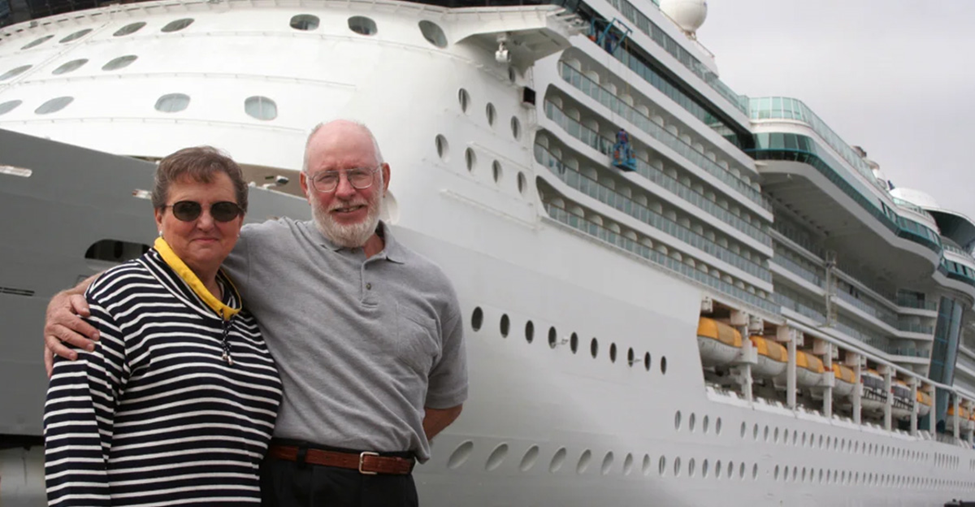Retiring On A Cruise Ship. What's Not To Love?
For many of us, retirement is a chance to slow down, enjoy the fruits of our labor, and maybe even indulge in a lifelong dream. But what if that dream doesn’t involve a quiet house in the suburbs or a cozy condo in Florida? What if, instead, it means waking up each morning to the sound of waves, sipping coffee on deck, and watching the sunrise over a different horizon every week? With $600,000 saved for retirement, the idea of spending your golden years on a cruise ship might sound daring—or downright impossible. The truth lies somewhere in between, and it all comes down to smart planning, realistic expectations, and a love for life at sea.

The Allure Of A Floating Retirement
There’s something undeniably romantic about waking up each morning to a fresh sea breeze, endless ocean views, and the possibility of a new port each day. For many retirees, trading a traditional home for a floating one sounds like a dream worth chasing.
 I Tried Living On A Cruise Ship, Matthew Ables
I Tried Living On A Cruise Ship, Matthew Ables
Why Cruise Ship Living Is On The Rise
In the past decade, more retirees have swapped condos for cabins at sea, seeking a life of adventure. With predictable costs, a built-in social network, and travel rolled into one lifestyle, it’s no wonder this trend is catching on among adventurous souls.
 I Tried Living On A Cruise Ship, Matthew Ables
I Tried Living On A Cruise Ship, Matthew Ables
Setting The Stage: $600K In Retirement Savings
You’ve saved diligently, and now you’ve got $600,000 ready for your golden years. The big question: can that bankroll a permanent life at sea? The answer depends on your budget discipline, desired comfort level, and the cruise itineraries you prefer.
The Baseline Math For Retirement Spending
If you plan for your savings to last 25 years, that’s $24,000 annually before investment returns. With a modest 4% annual yield, you could safely spend closer to $30,000–$35,000 per year without burning through your nest egg too quickly.
 Photo By: Kaboompics.com, Pexels
Photo By: Kaboompics.com, Pexels
Average Costs Of Cruise Ship Living
Cruise fares vary wildly, typically from $100 to $250 per person, per day. At $100/day, you’re looking at $36,500 annually—already near your upper budget limit. Picking the right cruise line and timing is crucial to keeping costs manageable.
Ways To Lower The Per-Day Cruise Rate
Savvy long-term cruisers rarely pay full fare. By booking back-to-back repositioning cruises, traveling in shoulder seasons, and leveraging loyalty discounts, you could cut expenses by 30–50%, making ship life surprisingly affordable on a tighter budget.
Considering An Inside Cabin To Save Money
Inside cabins, with no windows or balconies, can be half the cost of ocean-view rooms. If you’re comfortable sacrificing direct sunlight for savings, you could drop to $50–$70/day—stretching your $600K much farther while still enjoying all ship amenities.
 Why you should book an INSIDE CABIN on a cruise ship, Royal Caribbean Blog
Why you should book an INSIDE CABIN on a cruise ship, Royal Caribbean Blog
What’s Included In Your Cruise Fare Price
Most cruise fares include lodging, unlimited meals, entertainment, and basic ship facilities. That means no grocery shopping, car payments, utility bills, or home maintenance. These built-in perks make full-time ship living more competitive with land-based expenses.
 I Tried Living On A Cruise Ship, Matthew Ables
I Tried Living On A Cruise Ship, Matthew Ables
What’s Not Included In Cruise Pricing
You’ll still pay for Wi-Fi, specialty restaurants, shore excursions, gratuities, and drinks. These extras can easily add $500–$1,000 per month if you’re not careful. Learning to limit splurges will be key to making your retirement budget work.
 Why you should book an INSIDE CABIN on a cruise ship, Royal Caribbean Blog
Why you should book an INSIDE CABIN on a cruise ship, Royal Caribbean Blog
The Healthcare Question For Cruise Retirement
Ships have medical staff, but they’re not hospitals. Serious issues require onshore care. You’ll need solid international health insurance and a plan for emergency evacuations or treatments—especially important if you have preexisting conditions or ongoing health needs.
 Episode 9: How I Sea It- The Medical Facility, Captain Kate McCue
Episode 9: How I Sea It- The Medical Facility, Captain Kate McCue
Visas & Legal Considerations At Sea
If you’re hopping between countries constantly, you must understand visa rules. Fortunately, cruise lines handle most port visas for passengers, but longer land stays may require your own arrangements. This paperwork can be a hidden complexity of the lifestyle.
Financial Cushion For Emergencies & Delays
Even at sea, life happens—medical issues, family emergencies, or unexpected itinerary changes. Experts suggest keeping $25,000–$50,000 liquid in an emergency fund, completely separate from your cruise budget, so you can act quickly when something unexpected comes up.
Selling Your Home Or Keeping A Land Base
Some retirees sell their homes, freeing capital and eliminating maintenance costs entirely. Others keep a small apartment or RV as a fallback. Owning a home base provides stability, but going “all in” offers maximum freedom and extra funds.
The Social Side Of Ship Life For Retirees
Cruise ships are inherently social, which is great for extroverts and even shy travelers looking for connection. You’ll meet fellow passengers, chat with friendly crew, and possibly become part of a quirky, tight-knit community that sails the world together.
 Why you should book an INSIDE CABIN on a cruise ship, Royal Caribbean Blog
Why you should book an INSIDE CABIN on a cruise ship, Royal Caribbean Blog
The Downsides Of Permanent Cruise Living
It’s not all umbrella drinks and turquoise seas. Cabins are small, internet speeds can be frustratingly slow, and seasickness is a real possibility. Plus, you might eventually miss the stability and comfort of a traditional home environment.
Alternatives To Full-Time Life At Sea
If full-time cruising feels risky, consider splitting time—six months on ships, six months ashore. This hybrid approach gives you variety, keeps costs down, and makes handling medical appointments, mail, and family visits much easier and less stressful.
The Investment Angle On Funding Cruises
If your $600K remains invested, the returns could cover much of your cruising expenses. A balanced portfolio earning 4–5% annually could generate $24,000–$30,000 a year, allowing you to cruise frugally without dipping too far into your principal.
Loyalty Programs & Perks for Frequent Cruisers
Frequent cruisers often earn free upgrades, onboard credit, discounted Wi-Fi, and even complimentary trips through loyalty programs. Over several years, these perks can be worth thousands of dollars, making cruise-ship living far more cost-effective.
Repositioning Cruises: The Hidden Bargain Option
Repositioning cruises happen when ships relocate for seasonal routes—like moving from the Caribbean to Europe. These trips can be surprisingly cheap, sometimes under $50/day, making them a budget-friendly way to stretch your retirement dollars further.
Health & Fitness While Living On A Ship
Cruise ships have gyms, pools, walking tracks, and group fitness classes. Staying active is absolutely doable, but you’ll need discipline to balance those workouts with tempting buffets and daily dessert tables that seem to call your name.
Family & Friend Visits At Sea
You can invite family and friends to join you for specific segments of your journey. Many retirees schedule itineraries so loved ones can meet them at certain ports, turning visits into mini-vacations for everyone involved.
The Emotional Factor Of Nomadic Life
Some retirees thrive on constant change, finding joy in new horizons each week. Others eventually find the lack of a permanent home tiring. Testing the waters with a few months at sea is a smart move before committing.
Doing The Realistic Retirement Budget Test
List your projected monthly cruise expenses, including extras, insurance, and emergencies. Compare the total to your sustainable yearly income from $600K. If the numbers work, great. If not, adjust your plan until it’s a comfortable, realistic fit.
Final Verdict: Can $600K Make It Happen?
Yes—if you’re comfortable with modest accommodations, enjoy deal-hunting, and stay flexible, $600K can fund a cruise-ship retirement. It’s a bold choice, but for those who love adventure, it’s entirely within reach with smart planning.
The Takeaway for Aspiring Cruise Retirees
Cruise-ship living with $600K is realistic for frugal, adaptable retirees who prioritize experiences over luxury. With careful budgeting, deal-seeking, and healthcare planning, your retirement could be one never-ending voyage to new ports and endless horizons.
Would You Retire On A Cruise Ship?
Retiring on a cruise ship isn’t for everyone, but for those with a taste for adventure, a willingness to live modestly, and a knack for finding deals, it can absolutely be done—even with $600,000 in the bank. By understanding the true costs, planning for healthcare and emergencies, and embracing the quirks of ship life, you can turn this unconventional dream into a sustainable reality. After all, retirement is about living life on your terms—and for some, that means letting the tide decide where tomorrow takes you.
 We Tried Retiring On A Cruise Ship, Grounded Life Cruises
We Tried Retiring On A Cruise Ship, Grounded Life Cruises
You May Also Like:
These Money Mistakes In Your 50s Could Prevent You From Retiring
Your 2025 Retirement Checklist
My work "invited" me to retire early, but I'm good at my job and I love it. What are my options?
























